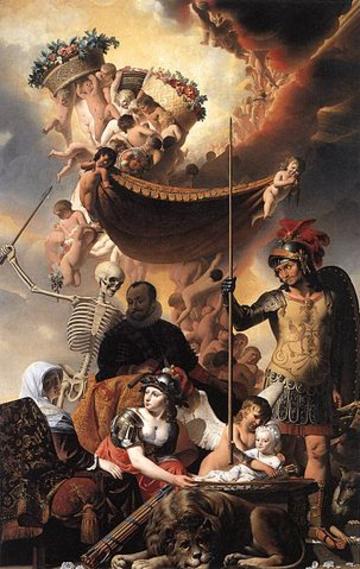War: The Beating Heart of the Dutch Republic

Caesar van Everdingen: Allegory of the Birth of Frederick Henry (Public domain, via Wikimedia Commons)
‘The spirit of monarchy is war and aggrandizement; the spirit of the republic is peace and moderation’, wrote Montesquieu admirably about the Dutch Republic and other ‘eternal republics’ of his time (Montesquieu, 1748, book IX, Ch. 2). To this day, republicanism has provided a positive narrative of war for the early modern Dutch Republic. Historians tend to argue that wars were undertaken neither for conquest and nor from the position of the aggressor, but primarily for the defence of Dutch commerce or liberty. Dutch colonial rule is also still often explained as essentially commercial and non-imperialist, that is non-violent. This view stems partly from the focus within historiography on the seeming paradox of how such a small, decentralised republic could overpower the great monarchies of Europe and beyond. The Dutch Republic seemed no proper fit for the theory of state formation, that is the assumption that early modern warfare evidently facilitated the rise of highly centralised bureaucratic states. As such, historians rendered it either a ‘miracle’ (Huizinga, 1941; Swart, 1969) or an ‘enigma’ (Prak, 2005, pp. 1-6) and thereby fostered, however inadvertently, strong elements of Dutch exceptionalism. They have played up ‘unique’ elements of the Dutch Republic (republicanism, commerce, liberty, an artistic golden age), whilst ignoring others, especially war.
Yet, war stood at the very heart of early modern Dutch society. First of all, the Dutch Republic was born out of war against Spain (1568-1648). In fact, seventeenth-century Dutchmen experienced virtually a ‘war without no end’ (Prak, 2005, pp. 25-26), while also enduring brutal civil conflicts. The Dutch Republic was no miraculous anomaly: it constituted a fiscal-military state like most early modern European states, the only difference being that it was a particularly efficient and successful one during the seventeenth and first half of the eighteenth centuries (Brandon, 2015). The Dutch were highly professional war-makers and had a thriving international business of war estimated at 10 per cent of the total economy in the seventeenth century (‘t Hart, 2014). ‘The European Fiscal-Military System 1530-1870’ investigates how entrepreneurial Amsterdam amongst other European cities functioned as a prime fiscal military hub within a wider international network, providing war goods from cannons to credit to allied regimes as well as enemies. This fiscal military system in Europe of ‘private’ suppliers fuelled European state formation, including in the Dutch Republic where local ruling elites were intrinsically linked to or even active in the lucrative business of war. Furthermore, the Dutch empire was established through often-violent conquest, such as the Massacre of the Bandanese of 1621 and the gruesome conquest of Makassar in 1667, both inflicted by the Dutch East India Company in name of the lucrative spice trade (Van Rossum, 2015). In sum, war permeated all levels of society from individual behaviour to the self-image of the Dutch Republic (Frijhoff & Spies, 1999).
Therefore, war needs to be uncovered, even if it is partially hidden –hidden because later generations have overlooked or downplayed its elements, and also hidden because Dutch contemporaries often preferred to understate their own part in violent warfare as well as drawing contrasts between their 'virtuous' selves and their Spanish and French enemies (Pollmann, 2018).

The Night Watch, Rembrandt, Rijksmuseum, Amsterdam (stock photo)
To this end, I believe we need to look beyond the politics and business of war: to dig deeper into, what I summarise as the culture(s) of war: the attitudes and orientations towards war in the Dutch Republic and early modern Europe. But what did a 'culture of war' exactly look like? How might we uncover it? In a previous post Jeannette Kamp wrote about the arms traders Louys and Hendrick Trip, who were pretty unabashed and blatant about the origins of their wealth. Just take one look at the Trippenhuis in Amsterdam, elaborately decorated with cannons and cannonballs. But what of the others? Were the Trip brothers exceptional? Besides businessmen, who were the other stakeholders in war (e.g. the House of Orange) and how did they relate to it? Was it already otherwise hidden in the 'Golden Age'? Or perhaps visible in unremarked ways, for instance in the famous painting The Night Watch by Rembrandt? And since warfare was in essence a transnational activity, how did a Dutch culture of war differ from its foreign counterparts? These questions have haunted me since I left my academic post to pursue a career in journalism and further other research interests, including into early modern culture(s) of war. First on my list, is to conceptualise ‘culture of war’. In the meantime, these questions will roam free.
After receiving her doctorate at the Erasmus University Rotterdam in 2016, Marianne Klerk was research associate at the University of Oxord Oxford on the pilot project ‘the Fiscal Military System, 1550-1850’, which laid the groundworks for the current ERC Horizon 2020 Project. She left the project to pursue a career in journalism and public history. As an associate to the project, she is exploring the early modern culture(s) of war. https://twitter.com/marianneklerk


